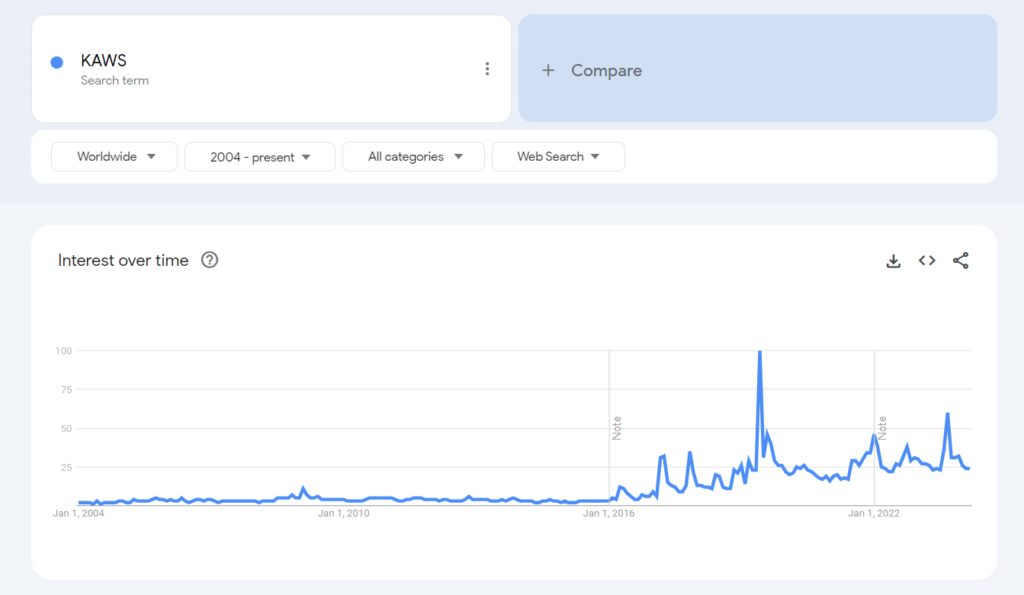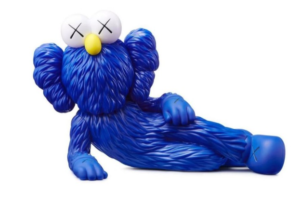The Kaws Craze: A Look Back and a Gaze Forward in Contemporary Art Collections
In the bustling and often enigmatic realm of contemporary art, few names have captured the zeitgeist quite like KAWS. The art community, as documented with flourish and eloquence in the hallowed halls of ARTnews, once penned a tale of the rise of ‘The Hypebeast Collector’. This blog post stands on the precipice to further the dialogue, to ask if the KAWS fever—once a blaze that transformed the landscape of contemporary art appreciation—has truly waned or evolved into a more nuanced form.
An idol of the New York street art scene, KAWS, or Brian Donnelly by his given name, blossomed from the concrete jungle into an international movement. His creations, from the silent cries of his signature "XX" figures to the reimagined pop-cultural icons with an undertone of melancholy, bridged the gap between the exhilarating rush of consumer culture and the timeless currents of artistic expression. But as the wheel of the art-world churns, the question lingers like a brush stroke suspended in a masterpiece—Has the collective obsession with KAWS stagnated, or is it merely in the throes of an evolution, as soul-stirring as his artwork itself?
In this immersive blog post, we shall unravel the impact of KAWS' career and creations, explore the trajectory of his market, and reflect on the narrative that binds the collective art aficionados through the ages. We'll traverse the domain of KAWS, not only through the lens of ARTnews but also through the very essence of his art—provocative and perpetually on the cusp of metamorphosis.
A Community Forged in Resin and Canvas


To understand the trajectory of the KAWS craze, we must first deconstruct the very essence of its existence. KAWS did not merely create art; he cultivated a community that extended beyond the physical boundaries of his exhibitions and into the ephemeral realms of social media, collaborated merchandise, and global iconography.
Art, at its core, is about connection. For KAWS, this was the warp and weft of his artistry. The poignant visage of cross-eyed figures, the monochromatic color palette, and the simplicity that belied a complexity of emotion—all were threads that wove a tapestry of relatability for a generation that reveled in cultural amalgamation.
The Birth of a Collective Consciousness
It was in the '90s, on the cobblestone streets of New York, that KAWS etched his first impressions, quite literally, onto the fabric of contemporary art. In anonymity, he seeded the first stirrings of a collective consciousness that would soon capsize the traditional mores of art collection.
His avatars, his murals that smoldered with subversion, and the clandestine entry into the urban art scene created the groundwork for what would soon explode into a global phenomenon.
The Internet as a Chisel for the New Age Sculptor
KAWS is as much a product of the digital age as he is a rebel against its monotony. His art, disseminated meticulously through online platforms, shattered the walls of elitism often associated with high art. It brought collector and connoisseur, the seasoned expert and the curious novice, onto a digital agora where the currency was engagement and the commodity, communion.
The Hypebeast Collector and the Maturation of Taste
The Hypebeast Collector emerged as a byproduct of this democratization of art. Fuelled by a populist appetite for the visually striking, many a zealot entered the art market through KAWS, only to find themselves metamorphosed by the purity of the artistic pursuit.
Some, like Miami's John Marquez, transitioned from collector to philanthropist, establishing the Marquez Art Projects dedicated to emerging artists that KAWS had inadvertently introduced to Marquez, binding his interest with the legacy he'll forge.
The Revolving Door of the KAWS Market
Art thrives not just on the passion of the collector, but on the wheel of the market. In this fluid canvas, KAWS' work saw a trajectory that paralleled the rollercoaster of streaking highs and wary troughs that characterizes contemporary art markets.
The Hype Economy and its Implications
The years as the new millennium dawned saw KAWS' creations surge in both cultural capital and financial value. The Hype Economy, voracious and volatile, gobbled up KAWS sculptures and canvases alike, sometimes with an insatiability that belied the contemplative nature of the art it venerated.
But as bubble economics attest, the peaks were followed by precipitous drops. The market, with a KAWS tag emblazoned like a branding iron, tested the mettle of the fervent Hypebeast Collector. Collections were born, acquired with fervor, only to be reshaped, reformed, as collectors, guided by the spell of KAWS, progressed along the evolutionary ladder. If we examine Google trends for "KAWS" starting in 2004, we can see that there was very little interest in the term. It wasn't until January 2017 that we can see a significant increase in interest for the term. The highest level of interest was reached in May 2019. This mirrors the rise and fall of KAWS in the market.


The Serendipity of Auctions
Auctions often serve as a barometer of an artist's market standing. KAWS' explosion onto the global art scene saw his pieces commanding record-breaking prices at auctions, like the 2019 sale of "The Kaws Album" for $14.8 million at Sotheby's. But as the market evolved, so did KAWS' position in it. In 2020, "The Kaws Album" was re-auctioned by Christie's and fetched $22.8 million—a testament to both the maturation of the Hype Economy collector and the serendipity of auctions as a measure of an artist's legacy. From the wheel to the market, from a community forged in resin and canvas to an artistic revolution etched on the digital landscape, KAWS remains a cultural icon, perpetually evolving yet always rooted in his passion for cultivating connections through art.
The Post-COVID Lull and the Winds of Change
The KAWS phenomenon did not emerge unscathed from the crucible of a pandemic that disrupted not only travel plans and art fairs but the very psyche of the art collector. The post-COVID lull, as documented through the observations of collectors and experts, seemed to cast a pall over the Hypebeast Collector.
Yet, in the stillness, one sensed a stirring. A profound reevaluation, a recalibration of taste and understanding, as the Hypebeast Collector began a dialogue with the more seasoned connoisseur of art. As prices for KAWS' work found equilibrium, art lovers diversified their interests, no longer singularly fixated on the ephemeral thrill of the chase.
KAWS Art and the Eternal Art-World Darwinism
The world of art is one of eternal Darwinism. Like the subjects of his resin sculptures, artists must adapt or face the dimming of the spotlight that once illuminated their heralded creations. KAWS stands at a crossroads that is less a denouement and more a prologue to the next chapter in contemporary art's annals.
The Artists He Has Spawned
Like a torch passed onto a new generation, KAWS has spawned artists who choose to tread the paths he blazed. The legacy is not just in the art but in the artists admired, in the circles they influence, in the communities they foster.
The 'System Failure' mural that he unveiled during Art Basel Miami Beach, created not just with an artist's hand, but an artist's heart, served as a moment of reflection for both creator and audience. It is a confluence of assurance and apprehension, of contentment, and the relentless pursuit of a vision that often eludes artists as their legacy wavers on the precipice of patronage and pandemonium.
Balance in the Scale of Artistic Achievement
As we stride forth, it is the balance in the karmic scale of artistic achievement that will become KAWS' ultimate testament. Gone is the folly of fanaticism, replaced by the fervor of the true contemporary art collector. The very existence of KAWS, in the oeuvre of his contemporaries and the art-worship of his connoisseurs, testifies to the longevity of his impact.
His art, like his legacy, is no longer the exclusive domain of the 'hyper'; instead, it has found its pace in the steady rhythm of an art world that oscillates between the audacious and the austere, the monumental and the minuscule.
In short: A Transition, Not an Extinction


In the end, we see the KAWS fever not as a moment extinguished but a transition—the evolution of taste, the maturation of the collector, the transcendence of the artist. The KAWS obsession, if it has waned, has done so not in the flickering embers of an ardent blaze but in the quiet illumination of an art form that continues to stretch the canvas of the possible.
Art, in all its manifestations, is a voyage. It is an artifact of its time and a prophecy of the future. The KAWS fever may have receded from its peak, but in its ebb, it reveals the eternal verities of artistic creation—not in the tides that pull it to cultural shores but in the depths that art collectors are willing to plumb.
Through its articles like this, ARTnews has not only chronicled the art world's voyage but has been a beacon for art aficionados to chart their own courses. The KAWS phenomena, perhaps, was a mere stopover in the vast voyage of art, and as we close this chapter, we look to the next with anticipation and awe.
The KAWS art movement is not extinct—it is evolving, and it beckons us to evolve with it, to appreciate the contemporary as a continuum rather than a craze. It urges us not to mourn the fading of a phase but to muse over the dawn of a new one. For in its wake lie the canvases yet to be painted, the sculptures yet to be chiseled, and the collectors yet to be inspired. And if you are interested in a KAWS figure take a look into Artsper.





